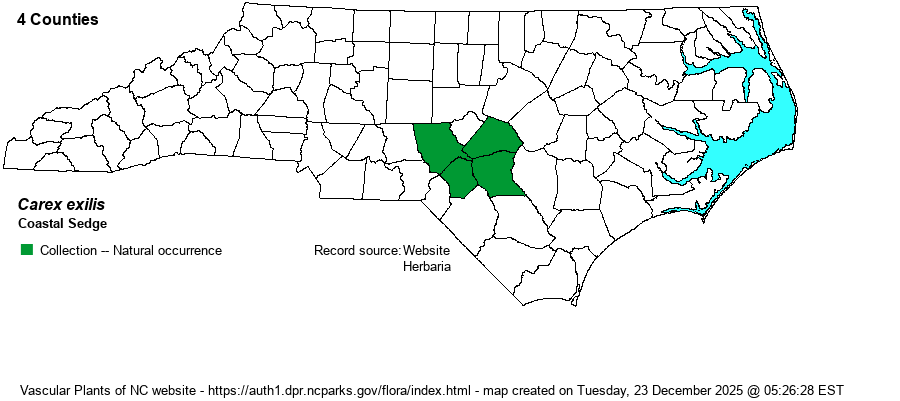| Author | Dewey | |
| Distribution | Strictly the Sandhills, though lacking collections so far from the southern Sandhills counties of Richmond and Scotland.
Lab. to Ont. and MN, south to DE and MI; disjunct to the Sandhills of NC and then again to pitcher plant bogs of southern AL and MS. | |
| Abundance | Rare. Populations are small at the NC sites, of which the NCNHP lists just 10, with 7 still considered extant. It is a State Endangered species, and now State Ranked at S1. | |
| Habitat | Seepage bogs, ecotones of streamheads in Longleaf Pine communities. |
| Phenology | Flowering and fruiting May-June. | |
| Identification | This is one of a few sedges in NC to possess only a single spike per stem; thus, plants are either male or female, or may produce both male and female flowers in the solitary spike. Flowering stems grow 1-2 feet tall. | |
| Taxonomic Comments | None
The genus Carex is the largest in North America, and among the largest in the world. In temperate and boreal regions, Carex is often the dominant or co-dominant ground layer in many habitats. Seeds (achenes) are valuable food for birds and small mammals, while foliage is used by birds and mammals to make nests and as food by mammals. Species of Carex often look vastly different from one another -- spikes erect vs. drooping, tiny inflorescence vs. whopping, culms leafy vs. naked, perigynia beaked vs. beakless, stems densely bunched vs. single, etc. The genus has been divided into many sections (or groups), based on shared characters; some taxonomists have suggested that these be different genera, but that proves unworkable (so far). All Carex share the feature of a perigynium (an outer covering) which completely surrounds the achene (seed). This covering may fit tightly or loosely (like a small bladder), depending on which group or species. Details of perigynia shape, ornamentation, presence and size of beak, number of striations (or veins) are all important ID features. In recent years Rob Naczi and colleagues have stressed the importance of arrangement of perigynia -- whether spiral (3+ ranks) or distichous (2-ranked) -- and have named a number of new species as well as split off some older synonyms. Therefore, RAB's (1968) key, excellent for its time, can only be used in a general way today. Members of some sections of Carex are difficult to key out (notably Ovales, Laxiflorae, Griseae); this is in part due to variation among individuals of a species, or failings of the key. FNA has drawings of most species and some species may be found in two or more places within a key, to acount for variability. New species to NC, and new to science(!), continue to be found in NC. | |
| Other Common Name(s) | Meager Sedge. Though most references do use Coastal Sedge as their common name, this species ranges far west of the coast and Coastal Plain, as far west as MN! | |
| State Rank | S1 | |
| Global Rank | G5 | |
| State Status | E | |
| US Status | | |
| USACE-agcp | OBL link |
| USACE-emp | OBL link |

